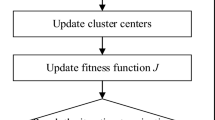Abstract
The existing building surface data fusion algorithms do not extract the segmented data features, resulting in inaccurate fusion results. In heterogeneous environment, a Clustering Fusion Algorithm Based on mutual information and fractal dimension is proposed. The regression coefficient is used to express the sequence, and the data feature representation and data dimension reduction are realized. The dynamic data series are processed by similarity measure function method. For the long dynamic data series, the piecewise aggregation approximation method is used to segment the data and then extract the features. Through the incremental clustering processing data based on fractal dimension clustering algorithm, the research of data fusion algorithm is realized. The experimental results show that the accuracy of building surface data fusion is greatly improved by using the dynamic data fusion algorithm, the highest is 0.98, the sum of square error is reduced, and the lowest is only 90.44.



Similar content being viewed by others
References
Sonebi M, Grünewald S, Cevik A et al (2016) Modelling fresh properties of self-compacting concrete using neural network technique. Comput Concr 18(4):903–921
Rastegarnia M, Sanati A, Javani D (2016) A comparative study of 3D FZI and electrofacies modeling using seismic attribute analysis and neural network technique: a case study of Cheshmeh-Khosh oil field in Iran. Petroleum 2(3):225–235
Ndiaye NM, Sens P, Thiare O (2016) Performance comparison of hierarchical checkpoint protocols grid computing. Int J Interact Multi 1(5):46–53
Sathish K, Reddy RM (2016) Workflow Scheduling in Grid Computing Environment using a Hybrid GAACO Approach. J Instit Eng 98(1):1–8
Liu S, Wang S, Liu X, Lin CT, Lv Z (2020) Fuzzy detection aided real-time and robust visual tracking under complex environments. IEEE Trans Fuzzy Syst. https://doi.org/10.1109/TFUZZ.2020.3006520
Liu S, Bai W, Liu G, Li W, Srivastava HM (2018) Parallel fractal compression method for big video data. Complexity 2018:2016976. https://doi.org/10.1155/2018/2016976
Shuai L, Xinyu L, Shuai W et al (2020) Fuzzy-aided solution for out-of-view challenge in visual tracking under IoT assisted complex environment. Neural Comput Applic. https://doi.org/10.1007/s00521-020-05021-3
Roger MS (2016) Introduction to statistics and data analysis. Technometrics 44(1):90–90
Chen YW, Zhang L, Ma HC (2018) Research on building extraction method of LiDAR data based on multi-scale fitted surfaces. J Geomatics Sci Technol 35(5), 49–54+60
Goldstein BA, Navar AM, Pencina MJ, Ioannidis JP (2016) Opportunities and challenges in developing risk prediction models with electronic health records data: a systematic review. J Am Med Inform Assoc 24(1):198–208
Jiang W, Xie C, Zhuang M, Shou Y, Tang Y (2016) Sensor data fusion with Z-numbers and its application in fault diagnosis. Sensors 16(9):1509
Chen XJ, Wang DH (2017) Face recognition based on BEMD and fractal dimension. Comp Eng Appl 6(10):177–180
Oliveira FDS, Figueiredo JJSD, Oliveira AG et al (2017) Estimation of quality factor based on peak frequency-shift method and redatuming operator: application in real data set. Geophysics 82(1):1–12
Paola PD, Giudice VD, Cantisani GB (2017) Rough set theory for real estate appraisals: an application to Directional District of Naples. Buildings 7(1):12
Kuang L, Hao F, Yang LT et al (2017) A tensor-based approach for big data representation and dimensionality reduction. IEEE Trans Emerg Top Comput 2(3):280–291
Hvidberg CS, Keller K, Gundestrup N et al (2017) Ice-divide flow at Hans Tausen Iskappe, North Greenland, from surface movement data. J Glaciol 47(156):78–84
Kumar D, Srinivasan S (2019) Ensemble-based assimilation of nonlinearly related dynamic data in reservoir models exhibiting non-Gaussian characteristics. Math Geosci 51(1):75–107
Li H, Zhang H, Lv GJ (2018) Construction of Building Data Based on Remote Sensing Images. Technol Earthquake Disaster Prevent 13(1):168–176
Bian Z, Ishibuchi H, Wang S (2019) Joint learning of spectral clustering structure and fuzzy similarity matrix of data. IEEE Trans Fuzzy Syst 27(1):31–44
Chen X, Peng S, Huang JZ et al (2017) Local PurTree spectral clustering for massive customer transaction data. IEEE Intell Syst 32(2):37–44
Bousbaci A, Kamel N (2017) Efficient data distribution and results merging for parallel data clustering in Mapreduce environment. Appl Intell 48(6):1–21
Shuai L, Zheng P, Xiaochun C (2017) A novel fast fractal image compression method based on distance clustering in high dimensional sphere surface. Fractals 25(4):1740004
Wei W, Fan X, Wozniak M, Song H, Li W, Li Y, Shen P (2018) H∞ control of network control system for singular plant. Info Technol Control 47(1):140–150
Acknowledgements
This paper is supported by the Major projects of science and technology in Inner Mongolia with No. 2019ZD016.
Author information
Authors and Affiliations
Corresponding author
Additional information
Publisher’s note
Springer Nature remains neutral with regard to jurisdictional claims in published maps and institutional affiliations.
Rights and permissions
About this article
Cite this article
Zhu, J., Gao, J. Dynamic Fusion Algorithm of Building Surface Data in Heterogeneous Environment. Mobile Netw Appl 26, 449–458 (2021). https://doi.org/10.1007/s11036-020-01677-2
Accepted:
Published:
Issue Date:
DOI: https://doi.org/10.1007/s11036-020-01677-2




